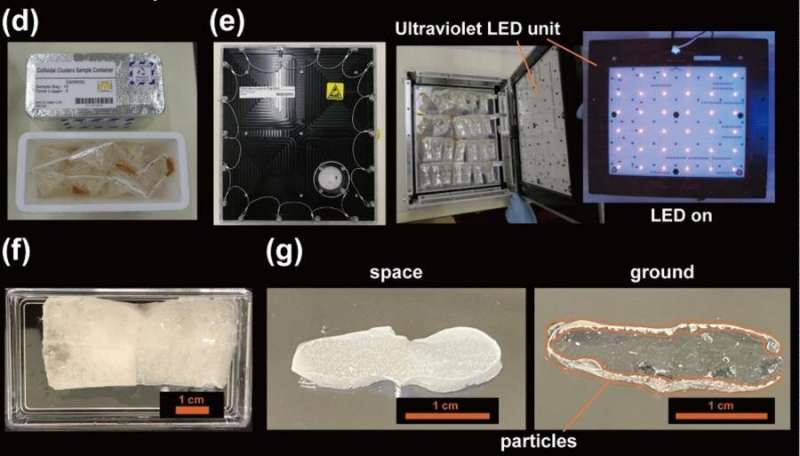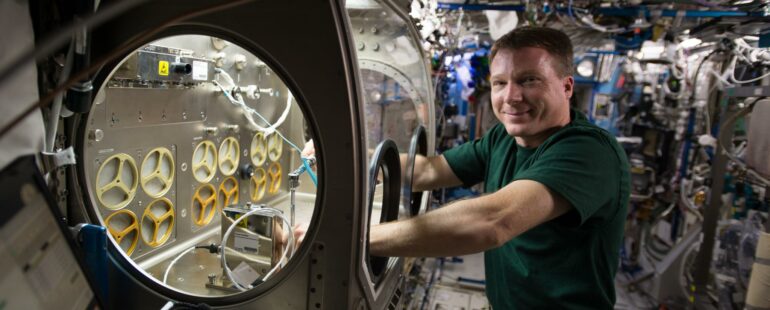A study conducted by group of scientists from Nagoya City University (NCU), Japan Space Forum (JSF), Advance Engineering Services (AES), Japan Aerospace Exploration Agency (JAXA) and ANSTO has revealed a clustering of charged particles in the microgravity environment of International Space Station (ISS), with implications for the development of photonic materials, improved drugs, and a range of new and innovative materials that depend on the mixing of two or more charged particles.
The experimental study, which was published in npj Microgravity, and conducted on the ISS, determined how sub-micron sized charged colloidal particles interact in the presence and absence of Earth’s gravity.
“Many chemical and physical phenomena rely heavily on an understanding of how two particles interact with each other, especially charged particles,” said ANSTO principal scientist and co-author, Dr. Jitendra Mata.
“The best example is when colloidal particles form tetrahedral clusters, commonly known as diamond lattices, which are essential in producing photonic materials. Controlling the self-assembly of colloidal particles enable us to construct a novel material that can be used in photonic, optoelectronics, sensing and clinical diagnostics.”
It is well known that even the slightest gravitational sedimentation and convection on Earth affects particle interactions and their arrangement in a colloid. This hinders important knowledge about the effect of charge.
This knowledge can also help to design better drug formulations, which will have higher self-life and better efficacy.
In this study researchers selected positively and negatively charged lighter particles and heavy particles. Polystyrene particles are only as heavy as the aqueous medium that contains them, and titania particles are roughly three times heavier than the medium.
Samples were immobilized in a gel after their interaction so they could be brought back to Earth for various experiments.

(d) Sample bag, consisting of two tetra-pack compartments connected via a breakable separator (e) The UV irradiation system. (f) Sample (Titania #23) returned to the ground and (g) Cross section of the gel-fixed space sample and the ground sample. © Australian Nuclear Science and Technology Organisation (ANSTO)
The research revealed that clusters formed by lighter particles in space are 50% larger than clusters formed on earth. This is ground-breaking finding as it was not expected for lighter particles.
For heavy particles, such as titania, an electrostatic interaction and cluster formation was also confirmed which it is not possible at all on Earth.
This study also needed an engineering marvel, in terms of designing the experimental setup for the mixing of samples in space and immobilizing these samples after mixing.
After the project was selected by JAXA, the team worked closely with multiple organizations to make a custom-built setup which can allow for the mixing and immobilizing of clusters in gel using LED-UV light.
Two sets of samples were prepared in Japan; one was sent to ISS using a Falcon rocket (Space-X) and Dragon SpX-19 transporter and the other was used in a ground experiment. The ISS crew used the prescribed procedure to mix the samples before curing them with LED-UV light. After spending more than a year in space, samples were returned to Earth and sent to different institutes for analysis.
A set of samples came to ANSTO, home to two state-of-the-art reactor based instruments: Quokka—Small Angle Neutron Scattering (SANS) and Kookaburra—Ultra Small Angle Neutron Scattering (USANS).
“Quokka and Kookaburra are unique instruments which provided unparalleled information on the structure of clusters, which is very hard to study by other techniques. With contrast variation SANS and USANS, it was possible to gain information on the individual components in the clustering process,” said Dr. Mata.
Combined data from these two instruments provided important knowledge of structural morphology and the charge-charge interaction of colloidal particles from ~1 nm to 10 µm, without compromising the crystal environment of the samples. The study also features many other techniques including mathematical modeling and simulations.
More information:
Hiroyuki Miki et al, Clustering of charged colloidal particles in the microgravity environment of space, npj Microgravity (2023). DOI: 10.1038/s41526-023-00280-5
Provided by
Australian Nuclear Science and Technology Organisation (ANSTO)
Citation:
Study reveals understanding of a basic physical property of charged particles in microgravity (2023, June 2)
